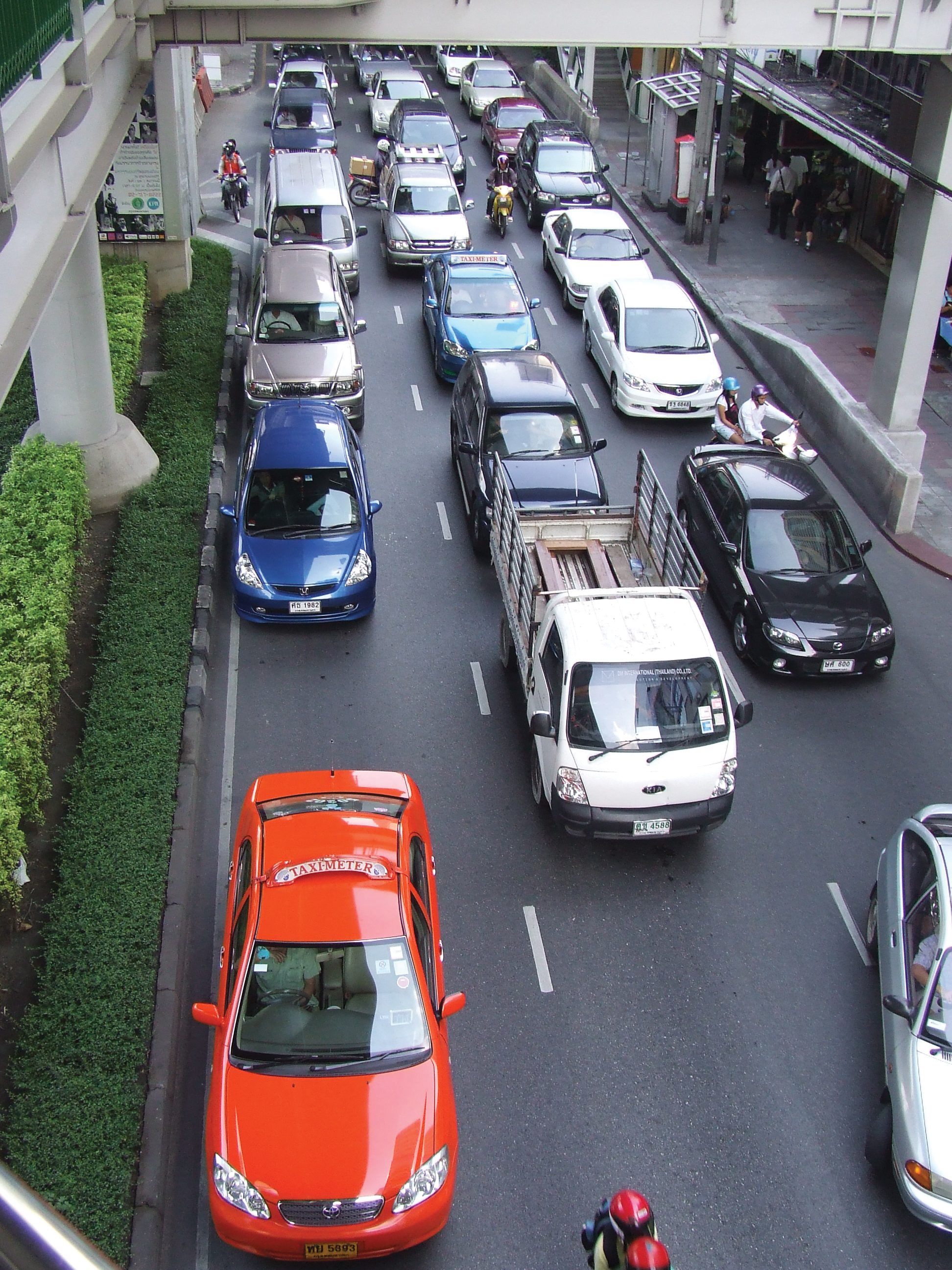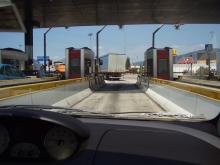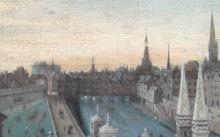Max Lay discusses how congestion has posed problems throughout history from early civilisation to the present day One of the earliest known human settlements was at the Springs of Elisha at Jericho. Inevitably, locals collecting fresh water from the springs would encounter other water carriers. When a path was too narrow, or access to it was too limited, or it crossed another path, some carriers would find it necessary to stand aside for others. Priority in such cases might be based on common courtesy and p

Bangkok features extremely crowded urban roads at present, although pedestrian traffic in large cities in the 19th century would actually have been more intense at peak periods
Max Lay discusses how congestion has posed problems throughout history from early civilisation to the present day
One of the earliest known human settlements was at the Springs of Elisha at Jericho. Inevitably, locals collecting fresh water from the springs would encounter other water carriers. When a path was too narrow, or access to it was too limited, or it crossed another path, some carriers would find it necessary to stand aside for others. Priority in such cases might be based on common courtesy and pre-ordained rules, but might also reflect the relative power and might of individual travellers.The same traffic events occur at different scales in all family homes, settlements, villages, towns and cities and on country-to-city, inter-city and production-to-market routes. Typically, it occurs as a consequence of many individual decisions. The paths and roads are largely self-managed, intersecting and over-lapping, and often inadequate for their purpose. The users operate independently but are guided by implied protocols, formal regulations and passive control devices. Travellers accept delays to their individual traffic movements. The situation is heightened by recent traffic-engineered systems which require travellers to halt at stop-signs and red traffic-signal lights, even in the absence of other travellers. Nevertheless, traffic in today’s communities commonly functions effectively, with travellers behaving in an orderly and courteous manner and, if stopped, waiting with stolid acceptance.
When do these stops and delays become intolerable and unacceptable? When might a trip be described as congested? The everyday term traffic congestion is usually associated with the implication that congestion is wasteful, inefficient and undesirable. And yet, to some, congestion indicates a strong economy and a vibrant community throbbing with interchange and interest. Roads and streets that are alive with hustle and activity have great social appeal and are perceived as far better than deserted streets and sterile orderliness. In the early twentieth century a number of US cities demonstrated their modernity by boasting about their busy streets and displaying photos of their congested traffic.
In considering this dilemma it is important to note that transport is a derived demand. It is not a waste product; rather it is the blood supply of an active body. Communities reach a balance between the benefits of traffic and its various adverse effects. Congestion may well be an unavoidable but manageable consequence of a transport system.
Nevertheless, it is more common to encounter the gloomy accounts of traffic congestion, particularly since the advent of the motor vehicle – although the underlying concern predates the car. The otherwise perceptive 1963 Buchanan report on traffic in British towns under the heading ‘An urgent situation’ included the italicised statement that ‘The problems of traffic are crowding in upon us with desperate urgency’. Half a century later, few cities have installed even half of the anti-congestion measures then advocated and there have been no cities ‘strangled to death by traffic congestion.’ A 1992 Brussels EC White Paper had predicted ‘We are heading towards an intolerable situation which will lead to the cardiac arrest of the transport system’. Gérondeau then observed the common opinion that congestion would inevitably worsen and cities come to a standstill, despite many trips being made without encountering congestion. The Texas Transportation Institute publishes annual data on congestion in US cities which continues to support Gérondeau’s views. For the largest cities, the current overall average loss per trip is 6 minutes, with Washington the worst at 8 minutes.
There are other signs that congestion is not necessarily the ogre that had often been implied. For instance, the last comprehensive transport plan for Melbourne was issued in 1969 when it had a population of 2.5 million and less than 10km of low-standard freeway. To manage Melbourne’s traffic and avoid congestion, the Plan proposed 510km of freeways, including a grid of inner city freeways that would have destroyed much of its core of inner suburbs. Today, Melbourne has a population of 3.9 million but only about 150km of freeways and while its road system is heavily used it functions effectively.
A different clue to resolving the dilemma was recently offered by Weinstein after reviewing some Boston traffic history: ‘When people complain about congestion, they are actually complaining about some set of negative conditions or events that they perceive the congestion to cause.’ Congestion may well be a label for a range of other ills created by the traffic system. The word came to English from Latin and has consistently meant an accumulation or heaping, particularly in a medical context. According to the OED, it began to refer to overcrowded conditions in the 1860s and to crowded traffic in the 1890s. ‘Traffic jam’ is a term introduced by the Saturday Evening Post in 1910 which explained its invention as ‘The British word ‘blockage,’ a holdover from horse-and-carriage days, was too civil-sounding to convey the awful noise and smell of automobiles densely packed into a tight space.’
Congestion certainly existed before the motor car. Major traffic congestion arose around the docks and quays at times of peak trade. In 18th &19th centuries the width of the Thames through London could be totally blocked by ships loading and unloading cargo.
On land, congestion in pre-car days had a significant pedestrian component. The bridges across the Thames in London of the 19th century were crowded to an extent that is scarcely believable. Early photographs from Philadelphia and New York show major congestion involving pedestrians and horse-drawn vehicles.
There are various commercial responses to such ‘demand exceeds supply’ situations, such as making customers queue for service – the do-nothing response. Conversely it is possible to enlarge the service – the ‘build more roads’ option, and the construction of Blackfriars Bridge in London in the 1760s was done partly to clear the riverbank of noxious slums near Fleet and partly to take some traffic off London Bridge. Baron Haussman who rebuilt 19th century Paris held no brief for the past and to accommodate the major radial roads that met in congestion on the Île de la Cité, he demolished all the medieval buildings that surrounded Notre Dame Cathedral. Other options include raising the service price – historically by bridge and entrance tolls or creating new destinations which were more attractive than existing destinations. This option was behind the development of many “New Towns” over the last two centuries. An earlier regal example occurred in France during the reign of Louis XIV. Traffic blockages on the narrow Parisian streets were a prime reason why the King moved his palace to Versailles late in the 17th century. Meanwhile it is also feasible to provide alternative services – typically by public transport; extend service hours – but with few historical precedents; reduce demand – also with few historical precedents.
The street and access improvements that did occur in cities like Victorian London in response to congestion were incremental and localised and rarely part of a larger plan. They often relocated the problem rather than reduced it, or left the cure uncompleted.
Once city land-use was entrenched, it was usually expensive and politically difficult to provide new transport infrastructure unless backed by dictatorial powers. High inner-city land values and influential vested interests made the implementation of new schemes almost impossible. Power and influence and wealth creation typically resided far more with land owners than they did with transport users and operators.
A compounding issue has been that alternative routes do not develop naturally in cities. There would be no commercial or practical incentive for this. Land-owners and traders on busy routes do not look kindly on the loss of (slowly) passing customers. Likewise, ring roads are not a natural consequence of city development.
An associated dilemma has been that transport demand and, recently, transport technology have changed more rapidly than land-use and both have tended to raise rather than diminish land values. For instance, the end of the 19th century saw the arrival of the self-powered motor vehicle. Before that time, congestion was an event that a traveller came upon, thought about and then worked around. With the coming of the car, travellers encountered congestion too quickly to do other than join the growing queues.
Steam power mainly serviced inter-city travel and had little positive impact on urban traffic congestion. Massive new infrastructure was clearly essential. The major break through occurred in 1870 when the electric generator was invented and in 1879 when Werner von Siemens in Berlin developed methods of supplying this electric power to moving vehicles. There followed a boom period of public transport expenditure with a concurrent escalation in the value of land serviced by the new facilities. However, many public transport facilities subsequently struggled to cover operating (or marginal) costs.
As horse usage peaked at the end of the 19th century there were many examples of traffic chaos due to horse-drawn vehicles. In 1879 the New York Times reported that horse-drawn vehicles had caused an ‘unprecedented’ five hour ‘blockade of traffic’ and a ‘nondescript jam’ on a stretch of Broadway near Wall St. Advocates of the new internal combustion vehicles were quick to point out how they would reduce the chaos and ease any congestion as they were smaller, faster and more mobile. What actually happened is a story for another time.







